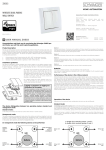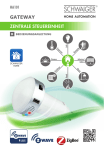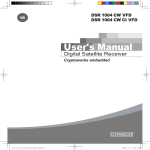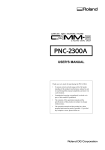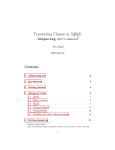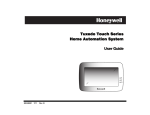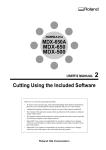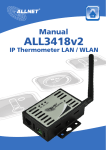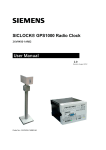Download CONTROL CENTER
Transcript
HA101 GATEWAY HOME AUTOMATION CONTROL CENTER Mo tio per Tem n Light USER MANUAL re atu Dimming Blinds Smoke od Ra di Flo ato r SCHWAIGER HOME Congratulations and thank you for purchasing the HA101 Schwaiger Product. The following product description will provide you with useful information about its use. Internet: www.schwaiger.de Service-Hotline: +49 9101 702-199 2 TABLE OF CONTENTS 1 PRODUCT DESCRIPTION...................................................................................... 4 2 HA101 GATEWAY................................................................................................. 5 3 TECHNICAL INFORMATION.................................................................................. 6 4 CONFIGURING THE SCHWAIGER HOME SYSTEM .................................................. 6 4.1 CONNECTING THE GATEWAYS TO HOME NETWORK...............................................6 4.2 REGISTERING THE USER’S ACCOUNT..................................................................6 4.3 ADDING THE GATEWAY TO THE USER ACCOUNT...................................................7 4.4 Home-Installation........................................................................................7 4.5 MANAGING Z-WAVE-COMPONENTS ....................................................................8 4.6 ZIGBEE COMPONENTS.......................................................................................8 4.7 RESETTING THE GATEWAY, NETWORK AND FACTORY SETTINGS..............................8 4.8HA101 Button Assignments...........................................................................9 5 CLIENT APPLICATION MANUAL.......................................................................... 10 5.1 ACCOUNT MANAGEMENT................................................................................. 10 5.1.1 Creating a new account.......................................................................... 10 5.1.2 Updating account information.................................................................. 12 5.2 HOME CONFIGURATION................................................................................... 14 5.2.1 Adding a gateway to the account............................................................. 14 5.2.2 Removing a gateway from an account...................................................... 16 5.2.3 Home installation.................................................................................. 17 5.2.4 Device management.............................................................................. 18 5.2.4.1 Adding a new device.................................................................. 20 5.2.4.2 Removing a device..................................................................... 20 5.2.4.3 Removing a device from a previous network.................................. 20 5.2.4.4 Updating the device name and location......................................... 20 5.2.4.5 Expanding functional access in learning mode................................ 20 5.2.4.6 Setting the timeframe for registration & deregistration.................... 21 5.3 CONTROLLING DEVICES.................................................................................. 21 5.3.1 Controlling devices by type..................................................................... 21 5.3.2 Controlling devices by location................................................................ 22 5.3.3 Advanced device configuration................................................................ 23 5.4 CONFIGURING SCENARIOS.............................................................................. 23 5.4.1 Creating New Scenarios.......................................................................... 24 5.4.2 Executing a scenario.............................................................................. 26 5.4.3 Editing a scenario.................................................................................. 27 5.4.4 Deleting a scenario................................................................................ 27 5.4.5 Disabling a scenario............................................................................... 27 5.4.6 Enabling email notification...................................................................... 27 Compatible components......................................................................................... 28 3 1 PRODUCTION DESCRIPTION The Schwaiger Home app is a complete solution for intelligent living, which uses a variety of communications options for controlling household equipment. Access to the home system is assured through the use of cloud services and the user-friendly mobile control interface. Cloud Overview of the Schwaiger Home network 4 2 HA101 GATEWAY The HA101 gateway is the device that provides support for the home automation (HA) features. The gateway can control all of the home automation devices in the user’s home, such as the alarms, thermostats and more. The gateway will control devices that support one of the following communication protocols: Z-Wave, ZigBee or WlAN. It can query the status of the device in the home network and save it, as well as change the status and all configuration options. Includes Plug adapter for Schuko wall sockets free download on or The gateway is controlled from the client application, which can be downloaded to iOS 7.0 or later (Apple devices) or devices equipped with Android 4.0 or later. The app can be downloaded from the Apple Store and from Android Play, where it can be found using the Schwaiger name as the key word for searches. With the client applications, users can control their household devices and manage their accounts as well as the list of their gateways and configuration options. A cloud-based web application has also been made available for remote access through the gateway. Using this application, users can manage their account and their gateway updates. The cloud service can be found at https://home.schwaiger.de The gateway has three buttons. • Button 1 is used to add and remove Z-Wave devices. • Button 2 is used to add ZigBee devices. • Button 3 is used to restart the gateway, reset the gateway network and reset the factory default settings. The use of these buttons will be described in more detail in the corresponding sections of this manual (Page 9). 5 3 TECHNICAL INFORMATION Hardware Specifications • Electrical: ~100-240 V, 0.6 A, 50/60 Hz (only inside the home, up to a max. of 40° C) • Gateway connections using Ethernet and WLAN • Sensor connections using the Z-Wave and ZigBee protocols • LED-illuminated button for configuring devices • Status LED (dimmable) • USB port for (for backups, updates and more) 4 CONFIGURING THE SCHWAIGER HOME SYSTEM Configuring the Schwaiger Home system consists of four basic steps. 1. Connecting the gateways to the home network 2. Registering the user’s account 3. Adding the gateway to the user account 4. Home installation 4.1 CONNECTING THE GATEWAYS TO THE HOME NETWORK The gateway will be connected to the local home network with the help of Ethernet or WLAN connections. Once connected with the wall, the gateway will start operations (after 2 min.) and connect to the home network with the help of Ethernet connections, if the connected Ethernet RJ45 cables are working. If an Ethernet cable is not available, the gateway will start in WLAN Access Point mode, which is only used to configure the wireless network. All three LEDs will blink as long as the gateway in is Access Point mode. Connect the smartphone or tablet with the gateway access point to access the gateway configuration page. The SSID for the gateway has been assigned an identifier that will be displayed using the identifier “SSID:Schwaiger...”. Create a connection to the access point and enter „http://192.168.0.1” or „http://HA101” as the URL in the browser for the smartphone or tablet. The page that opens will allow an SSID and the password for the home network’s router to be entered. Internet connection will be required in order to register the gateway with the cloud service. The gateway can only be enabled and afterwards receive software updates. 4.2 REGISTERING THE USER’S ACCOUNT Users can authenticate gateways and mobile apps with the Schwaiger Home System using the user account. The user name for the account will be the email address that is required for registering the account. Account registration may be done through the client or the web application from https://home. schwaiger.de. To create a user account using the client application, the user must first make sure that their smartphone or tablet is connected to the local wireless network (WLAN). The Schwaiger Home app can then be started. Choose the Create New Account option on the login dialog and follow the setup wizard’s instructions. Schwaiger Home will ask for a valid email address to be entered as the user name. This email address will be used to send a link to activate the account. Additional legal information will be provided after tapping on the General Business Terms and Conditions and Data Protection Provisions link. Confirm the usage conditions to continue. 6 Additional account and personal information will be entered as part of following those instructions. Entry of all information regarding the account details is optional. It may be changed at any time. The asterisk (*) indicates mandatory entries. Upon completion, the account registration information will be sent to the cloud service. Once the user name and password have been validated, an activation link will be sent to the user by email. It may be several minutes before that email message arrives. Confirm the activation of the account by tapping the link in the message. (Check your Spam folder, just to be sure.) Additional information about account registration through the cloud application can be found in Section 5.1. (from page 10) 4.3 ADDING THE GATEWAY TO THE USER ACCOUNT Either a mobile application or a cloud service can be used to associate a gateway with a user account. To make the association using a mobile application, open the Schwaiger Home app and log into the user account. Select the Home Installation option from the main menu. On the subsequent Home Installation screen, select the Add Gateway option in the upper right corner. The new Gateway wizard will start and request a gateway SSID (secure SID), a password and a symbolic gateway name. (Page 15) The PWD (Password) is a unique identifier for every gateway device. It will consist of 12 characters (e.g. as 7CDD907E2AA3) and can be found on the device and in it packaging. The SID (Secure ID) is a unique, secret identifier for a gateway. It will consist of 16 characters (e.g. 000000012H5J93AC). This number can be found on the last page of the operating instructions. . Once As soon as the required information has been entered, tap the button to continue the gateway’s SID has been compared with others in the cloud and has not been assigned to another user account, the gateway will be added. The gateway must be connected with the same local network used with the Home Installation wizard. Additional information about adding a gateway to an account through the client application can be found in Section 5.2.1. (Page 14) 4.4 Home-Installation The Gateway Configuration option will become available after tapping the Home Installation option on the client’s main menu. To make the Options menu appear, tap and hold the Gateway button on the Home Installation screen. Select the Edit option from that menu. The option will start the Gateway Configuration wizard. In the first step, the user can change the gateway name. The gateway SID cannot be changed button to continue to the Setup Home once it has been added to the user account Tap the Assignments step. The user can manage the associated floors and rooms in a subsequent step. Adding the floors and rooms can be accessed by tapping the + option in the upper right corner. Tapping this control and holding it for a moment can remove each room and each floor. Once the user is happy button to continue to the Device Management step. with the home assignments, tap the 7 In this step, the user can add new devices by tapping the Find Devices button. This action will place all networks in a mode, which can add devices. Read the operating instructions for the selected components to do so. From the same screen, devices can be removed by tapping the device and holding it for a longer time, and then selecting the Delete option (regarding this, see the respective operating instructions). Z-Wave devices that have not been removed from the previous network must be removed first. This can be done using the Remove Device option on the in the upper right corner of the screen. (see page 18, Ill. 16) Settings menu Once the configuration of the gateway has been completed, tap the Home Installation wizard process. button to complete the Additional information about configuring a gateway and mobile device through the mobile app can be found in Section 5.2. 4.5 MANAGING Z-WAVE-COMPONENTS Please note, that the distance between the gateway and the clients shall not be more than 0.5 meters during integrating in/excluding from the network. Adding components using the mobile applications To do this, tap the Home Installation option on the mobile application’s main menu and select the device button by tapping it and holding it for a period. Go to Add Device to introduce a new component. If the network has been opened for integration (Find Devices), the LED will stop blinking and stay in the lit state. The user must connect the device during this period to add the Z-Wave device. To do so, follow the instructions in the device’s manual. Removing components using the mobile applications To do this, tap the Home Installation option on the mobile application’s main menu and select the device button by tapping it and holding it for a period. (see Image 13). Tap the Add Device menu in the upper right corner option. Select the Remove Device option from the Settings of the screen. The corresponding Z-Wave device must be removed from the network during the period indicated on the screen. To do so, follow the instructions in the respective user’s guide. Adding components using the gateway To add device to the Z-Wave network, the user must tap the 1 button and hold it for one to five seconds. The Z-Wave network will then open for the integration process. During that time, the LED will blink once per second. The user must connect the device during this period to add the Z-Wave device. To do so, follow the instructions in the device’s manual. The network will be closed when the button is tapped and held for five to ten seconds. During that time, the LED will blink four times per second. Once the network has been closed, the LED will turn off. Removing components using the gateway The network will be opened for removing devices when the button is tapped and held for roughly 10 to 20 seconds. During that time, the LED will blink ten times per second. The corresponding Z-Wave device must be removed from the network during the period indicated on the screen. To do so, follow the instructions in the respective user’s guide. 4.6 ZIGBEE COMPONENTS Adding ZigBee devices is done in the same manner as Z-Wave devices. The only difference is that the 2 button must be used. 4.7 RESETTING THE GATEWAY, NETWORK AND FACTORY SETTINGS Re-start the gateway Tapping the 3 button (and holding it for 1 to 5 seconds) will restart the gateway without affecting the existing configuration. 8 Re-start the network This function will permit the user to reset the network connection settings to factory settings. Once the network has been restarted, the gateway will be restarted. Once the network cable has been connected to the gateway after the network has been restarted, it will continue to use the network connection. If the network cable has not been connected to the gateway, the gateway will enter Access Point mode. Tapping the 3 button and holding it for 5 to 15 seconds will reset the network configuration. Factory settings The factory settings function will reset the gateway to the state in which it was delivered. Doing so will delete all of the saved data. Furthermore, all saved Z-Wave and ZigBee settings will be deleted as well as the scenarios already created. Tapping the 3 button and holding it for 15 to 30 seconds will reset to the factory settings. 4.8 HA101 Button Assignments The HA101 gateway has 3 buttons (numbered in sequence), which have each been assigned an lED. Certain features will be activated by tapping and holding the button for longer periods of time. Each buttons has been assigned a special feature. • Button 1: Managing the Z-Wave network • Button 2: Managing the ZigBee network • Button 3: System settings (reset) Z-Wave learning mode To enable the Schwaiger Home Gateway to add a new Z-Wave sensor, select learning mode. Tap the 1 button for Z-Wave components and hold it for 1 to 5 seconds to start learning mode. If a Z-Wave sensor should be removed, tap the 1 button (and hold it for 10 to 30 sec.) to remove the components from the gateway. ZigBee learning mode Follow the same procedure for the Z-Wave mode in order to register ZigBee components. Of course, the 2 button will be used for this feature (see the tables as well). The lEDs also provide information about the status of the gateway. Z-Wave Green ZigBee Button 2 Button 3 1 Green Green System Button 1 Sec. 0 5 10 15 Blinks 2Hz until network is opened Blinks 4Hz until network is closed Blinks 10Hz until network is closed Open network Close network Open network for exclusion Blinks 2Hz until network is opened Blinks 4Hz until network is closed Open network Close network Blinks 2Hz Blinks 4Hz Reset Reset network 20 30 Blinks 20Hz learn mode Blinks 10Hz Factory reset In the Access Point mode, all three lEDs will be turned on at a frequency of 2 Hertz. When starting the gateway, only the lED for the 1 Button will be turned on. Booting takes roughly 2 minutes. 9 5 CLIENT APPLICATION MANUAL 5.1 ACCOUNT MANAGEMENT 5.1.1 Creating a new account Ill. 1 Ill. 2 1. Tap the Create New Account button on the login dialog (see Ill. 1) 2. Enter a valid email address and the password on the login dialog. An activation link will be sent to the specified email address (see Ill. 2) 3. Agree with the General Business Terms and Conditions and Data Protection Provisions and tap the button . The complete text of the General Business Terms and Conditions and the Data Protection Provisions can be reviewed by tapping the General Business Terms and Conditions and Data Protection Provisions button. 10 Ill. 3 Ill. 4 4. Enter the account details and tap the button. Entries indicated by an asterisk (*) are mandatory entries. All other entries can also be filled in later (see Ill. 3) 5.Enter the your personal information and tap the (see Ill. 4) button to close the wizard 6. Once the account has been successfully registered, a message with an activation link will be sent to the email address specified in the account name (make sure to check the Spam folder). Otherwise, a failure notice will be displayed. 7. Confirm the activation link sent in the email message. 11 5.1.2 Updating account information Ill. 5 Ill. 6 1. To update the user account information, tap the user icon in the upper right corner of the main menu and select the Account Settings option. 2. The Account Settings wizard will be started. 3. The password for the account can be changed in the first step. To continue changing account details, tap the button. 12 Ill. 7 Ill. 8 4. Information about the account details can be changed in the second step. All of the entries are optional. To continue to the third step for updating personal information, tap the button. 5. Personal information can be updated in the third step. All of the entries indicated with an asterisk (*) are mandatory fields. All other entries are optional. 6. Tap the button to complete the Account Settings wizard process. 13 5.2 HOME CONFIGURATION 5.2.1 Adding a gateway to the account Ill. 9 Ill. 10 14 Ill. 11 Each account can register more than one gateway. Follow these steps to add a gateway. 1.Log into the account that should register the new gateway. 2. Select the Home Installation menu option to open a list of the gateways associated with the account (see Ill. 9) 3. Tap the Add Gateway option in the upper right corner to start the Home Installation wizard (see Ill. 10) 4. A gateway can be added to the account in the Add Gateway step. 5. Enter the Secure SID (SSID), password (PW) and a name as the gateway information. The gateway may only be added when the correct combination of SSID and password have been entered. 6. Tap the button to add the gateway and continue the home configuration process. If the gateway has been added, a success message will be displayed. Note: an Internet connection will be required for this option. 7. The home configuration can be setup in the subsequent steps, see Section 5.2.3. Note: gateway configuration will require a smartphone or tablet that is active in the same network as the gateway. 15 5.2.2 Removing a gateway from an account Ill. 12 Ill. 13 Follow these steps to remove a gateway properly. 1. Start the mobile app. 2. Select the Home Installation menu option to open a list of the gateways associated with the account. 3. Find the gateway in the list and tap the gateway button and hold it until the options menu is displayed. 4. Select the Delete option. 5. Confirm execution. 16 5.2.3 Home installation Ill. 14 Configuration of the home network uses the Home Installation wizard, as explained in 5.2.1. The home gateway must be in the same network as the smartphone or tablet. The home assignments and device management can be configured using the following options. Ill. 15 1. login to the account, to which the gateway was added. 2. Select the Home Installation menu option to open a list of the gateways associated with the account. 3. Find the gateway in the list and tap the gateway button and hold it until the options menu is displayed. 4. Select the Edit option. 5. Information about the name of the gateway can be changed in the first step. Tap the button to continue configuring the division of the floor(s). 6. The division of the floor(s) can be configured in the second step. To add a new floor, tap the + button in the upper right corner and enter a new floor name. To delete the floor, tap the opened Floor button and hold it, then tap the Delete option. All of the rooms associated with the floor will be deleted when the floor is deleted. Devices that are associated with those rooms will be moved into the unknown devices group. A floor name can be changed by tapping on the floor. 7. To continue configuring rooms, tap the button. 8. The rooms can be configured in the third step. To add a new room, choose the corresponding floor from the menu on the menu bar, tap the + option and enter the room name. To delete a new room, select the floor where the room is located, tap and hold the Room button to open it and then select the Delete option from the menu. All devices will be moved into the unknown devices group when the room has been deleted. A room name can be edited by briefly tapping on the room. 9. To continue managing devices, tap the button. 17 5.2.4 Device management Ill. 16 Ill. 17 To add a new device, follow Steps 1 through 9 from Section 5.2.3 to open the Home Installation wizard. To continue directly with the device configuration step, select the Find Devices option, as described in Section 5.2.4.1. In that manner, new devices can be added, existing devices removed, devices from the previous network removed, network switch settings made and device names and locations managed. 18 Ill. 18 Ill. 19 19 5.2.4.1 Adding a new device Please note, that the distance between the gateway and the clients shall not be more than 0.5 meters during integrating in/excluding from the network. 1. To add a device, tap the Find Devices button. This action will open a new window for integrating the device. The counter in the window will display the amount of time until the network will be closed again. 2. Integrate the device. This process may vary from device to device. Read the manual for the device. A guide that indicates how fully-supported devices can be integrated can also be found by tapping the Help option in the upper right corner of the screen. 3. If a device is added to a network, it will be displayed above the list of devices. 4. A symbolic name can be assigned using the Edit option by tapping on the device button and holding it and the device can be selected. (see Ill. 17) Please note that with battery-operated components, a Wake-up function has to be performed after successful registration with the gateway (the procedure is the same as including the component, e.g. pressing the button 3x with ZHS04). In case the range of the nearest repeater is not large enough, please use an additional power repeater. 5.2.4.2 Removing a device 1. To remove a device, tap on the device and hold it while selecting the Delete option. 2. The type of device (ZigBee or Z-Wave) will determine which of the following processes should be used. a. In the case of ZigBee devices, deletion merely needs to be confirmed. b. In the case of Z-Wave devices, the network will be opened for the deletion process. Once the network has been opened, the device must be deleted manually. Follow the instructions in the device’s manual for removing the device. 5.2.4.3 Removing a device from a previous network 1. Tap the Settings menu icon in the upper right corner and select the Remove Device option. (see Ill. 16) 2. When the dialog opens, the network will be opened for removing components. Follow the procedures for removing the device. Additional information can be found in the user’s manual for the respective components 5.2.4.4 Updating the device name and location By default a device will be assigned a predetermined name consisting of the device type and ID. The device will not be assigned to a room. To update the parameters (see Ill. 15): 1. Tap the device symbol and hold it. 2. Update the Edit entry on the Device Information dialog. 3. Choose the device location from the Location list. (see Ill. 18) 5.2.4.5 Expanding functional access in learning mode Access between the gateway and the components to be learned can be extended in learning mode. Check the corresponding checkbox to do this. (see Ill. 16) 20 5.2.4.6 Setting the timeframe for registration & deregistration 1. Open the Settings menu from the Device Configuration screen in the upper right corner and select Deactivate Network. 2. When the dialog is displayed, enter the descried timeframe for the duration in seconds. 3. Tap the OK button to confirm this action. 5.3 CONTROLLING DEVICES 5.3.1 Controlling devices by type Ill. 20 1. Select the Device by Type option on the application’s main menu. 2. To filter devices by type, choose a type from the menu on the left. 3. To release the filter, tap the home icon in the upper left corner. 4. In addition to filtering by type, a filter by location may also be applied, by choosing the device location using the option in the upper right corner. 5. Each device can be depicted and controlled using its own button in the middle of the application screen. (see Ill. 20) 6. Advanced device options will be made available by tapping on the device button and holding it. For more information, see 5.3.3. 21 5.3.2 Controlling devices by location Ill. 21 1. Select the Device by Location option on the application’s main menu. 2. To filter devices by type, choose a location from the menu on the left. 3. To release the filter, tap the home icon in the upper left corner. 4. In addition to filtering by type, a filter by location may also be applied, by choosing the device type using the option in the upper right corner. 5. Each device can be depicted and controlled using its own button in the middle of the application screen. (see Ill. 21) 6. Advanced device options will be made available by tapping on the device button and holding it. For more information, see 5.3.3. Ill. 22 a 22 5.3.3 Advanced device configuration Ill. 22 b 1. Select the Device by Type or Device by Location options on the application’s main menu. 2. Find the device and tap the device button and hold it to open the Advanced Device Configuration dialog. 3. Each change to the device properties will be immediately applied to the gateway and the device. 5.3.4 Special features Z-Wave components can be linked to an ID number and scenarios can be created, without the gateway being accessible. This only applied for certain components, which will display an ID number in the sub-menu, such as a remote control (ZHF01) linked to a radio wall socket (ZHS13). Regarding this, see Illustration 22. Enter the ID number associated with the corresponding component. This means that the ID number for the remote control will be registered with the radio wall socket and correspondingly the ID number for the radio wall socket with the remote control. 5.4 CONFIGURING SCENARIOS The state settings and events for the device can be configured using scenarios. Scenarios can be triggered by one or more activation events or devices, which are called triggers. A scenario can be deactivated. In that case, the scenario trigger will not be processed. A scenario can also be set so that it will send an email notification. The notification will be sent to the email address for the account. As needed, counter-scenarios can be programmed, such as the scenario: Window open & light(s) on; Counter-scenario: Window closed & light(s) off. 23 5.4.1 Creating New Scenarios Ill. 23 Ill. 24 1. To open the Scenario Configuration screen, tap the Scenarios option on the main application screen. 2. Tap the Add Scenario option in the upper right corner on the Scenario Configuration screen. 24 Ill. 25 Ill. 26 Adding triggers 3. To add a new device trigger to a scenario, tap the Add option in the upper right corner (see Ill. 23) and select the device or time trigger. a. On the Device Trigger dialog, choose the drive function that should activate the scenario. b. Choose one of the three options: Equals, Less than or Greater than. c. Set the value. 25 4. To add a new time trigger to a scenario, tap the Add option in the upper right corner (see the bottom right of the screen in Illustration 25) and choose the Time Trigger option. a. Select the activation time on the Time Trigger dialog. b. Tap the option button, if a one-time event is desired. In that case, choose the date when the event should occur. c. If the event should repeat, select the Weekly option button and the weekdays when the scenario should be executed. 5. To add the trigger, tap the OK button. 6. Repeat steps 3 through 5 until all trigger events have been added. 7. Tap the button in the bottom right corner to continue making device settings. Adding state settings for the device. 8. To add a new triggering component to a scenario, tap the Add option in the upper right corner (see the upper right corner of Illustration 26a) 9. Select the triggering device from the Add Device dialog and tap OK. The devices can be filtered by type or location by selecting the corresponding button at the top of the dialog. 10.After being added to the scenario, the button for the device will be available for state configuration. 11.Repeat steps 9 through 11 until all displayed devices have been configured. 12.To complete the scenario, tap the button in the bottom right corner. Setting a scenario name 13.Enter a scenario name in the depicted dialog and tap the OK button. 5.4.2 Executing a scenario 1. Select the Scenarios option from the main menu to open a list of available scenarios 2. Briefly tap the quick control for the scenario to execute the scenario. 3. Confirm execution. Ill. 26a 26 5.4.3 Editing a scenario 4. Select the Scenarios option from the main menu to open a list of available scenarios. 5. Tap the scenario button and hold it to open the options menu. Select the Edit option. 6. A wizard will be opened. Follow steps 3 through 13 from Section 5.4.1. 5.4.4 Deleting a scenario Ill. 27 1. Select the Scenarios option from the main menu to open a list of available scenarios. 2. Tap the scenario button and hold it to open the options menu. Select the Delete option (see Ill. 27). 3. Confirm execution. 5.4.5 Disabling a scenario 1. Select the Scenarios option from the main menu to open a list of available scenarios. 2. Scenarios can be enabled or disabled by tapping the upper right corner of the scenario button. toggle switch button in the 3. If a scenario has been disabled, the scenario button will be darkened. If the scenario is enabled, all features will also be enabled. 5.4.6 Enabling email notification 1. Select the Scenarios option from the main menu to open a list of available scenarios. 2. Email notification can be enabled or disabled by tapping the Send Email Notification option in the bottom left corner of the scenario button. 27 SENSORS YOUR PERSONAL SECURITY COMPATIBLE SENSORS FROM THE SCHWAIGER HOME AUTOMATION SERIES 3 in 1 multi-sensor • Movement - temperature humidity - light • Wall or ceiling mounting possible • Sensitivity adjustment prevents the detection of small animals • Movement - temperature - light • Can be used to control scenarios. • Endless automation possibilities with Z-Wave • Wall or ceiling mounting possible O ZHS 05 UT DO O R 4 in 1 multi-sensor Water sensor Smoke detector • Flooding - temperature - theft • Unique design • Alarm is triggered when a flood is registered • Ability to update via Z-Wave • Detects smoke early, safely and reliably • Automatic alarm functions to the controller or other components • Installed in an easy and adaptable manner ZHS 07 ZHS 08 Door and window sensor 4 in 1 multi-sensor • An alarm is triggered when a window or a door is opened in a secured state. • Manipulation protection against unauthorised theft of the sensor. • Automatic alarm function to the controller or other components via the Z-Wave signals ZHS 09 28 ZHS 06 • Sensor for recognition of open and/ or close windows and doors and for recognition of movement, temperature and light • Scene creation for linking multiple sensors • Manipulation protection against unauthorised theft of the sensor ZHS 10 Temperature sensor • Remote control with concealed radiator mounting • Automatic control of preset temperatures • Detection of open windows with switching to energy saving mode • Direct temperature input ZHD 01 CLIENT HDMI™ TV STICK HAUPTTEXT remote control incl. Client The SCHWAIGER® HDMI TV Stick is a receiver or controller for your TV. With the stick the user interface for controlling the Gateway is displayed on the screen. You can perform all the settings on your TV with the included remote. HAR 80 29 ACTUATORS YOUR PERSONAL HELPERS HAUPTTEXT COMPATIBLE ACTUATORS FROM THE SCHWAIGER HOME AUTOMATION SERIES 1-way/2-way wireless wall switch Adapter plug as switches • Switching connected devices on and off, e.g. for lawn irrigation or water fountains • Operation by means of a button or Z-Wave possible • Built-in repeater for greater coverage ZHS 03 ZHS 12 Adapter plug as a switch Adapter plug as a dimmer • Adapter plug outlets for devices up to max. power of 3500 W • Module for switching and controlling Z-Wave devices via the Gateway • Switching connected devices on and off • Dimming and the switching on and switching off of connected devices • Dimmers for halogen lamps (high voltage), incandescent lamps, halogen lamps (low voltage) with conventional transformer ZHS 04 ZHS11 Adapter plug as consumption gauge MICRO SMART DIMMER 30 O UT DO O R • Control of programmed scenarios • Switch can easily be attached to any location (e.g. the front door) • 4 buttons behind the rocker switch. • Range of about 30 m • Dimming status is recognizable by means of the RGB lED display on the device • Accurate performance measurement of power consumption • Direct visualisation of electricity consumption by means of RGB lED • Switching connected devices on and off • Smallest module of its kind • For the dimming of e.g. lights or fans • For retrofitting existing electrical installation for a Z-Wave-based system • linking with Z-Wave devices in own network • Installation behind the switch of a wall outlet • Operation parallel to mechanical button ZHS 13 ZHS 01 Thermostatic radiator Blind module • Module for temperature control of radiators • For valves with RA connections (30 x 1.5) or RAK (Danfoss snap fastener) • Operation via pushbutton or Z-Wave possible • Automatic control of preset temperatures • Control of roller and garage doors, awnings or blinds using the mini remote control or app • Integrated load measurement for automatic calibration • Extremely precise slat positioning • Detection of the end position ZHT 01 ZHR 01 Mini remote control • Control of scenarios and installed modules • with four programmable buttons for operation of individual Z-Wave devices (e.g. gate, light) • Individually extendable to other Z-Wave devices ZHF 01 EXAMPLES Your comfort temperature Your energy savers CONTROL OF MORE THAN 1000 DEVICES via smartphone, Tablet or TV Your safety Your comfort AND MUCH MORE... 31 Important safety information! Installation must be carried out by competent persons. Before setting up and first using the unit, please read and follow the safety instructions carefully. Safety and installation information All of our products at the time of purchase conform to the currently applicable safety regulations and are, when used as intended, completely safe! Please heed the following information to avoid any potential dangers, damage or faults: Set-up information The heat generated when the unit is in operation must be dissipated by adequate air circulation, so the unit must not be covered up or situated in a closed cupboard. To avoid both the equipment damage and possible subsequent damage, only designated equipments should be installed on a flat surface for wall mounting.Make sure that the ventilation slots and the cooling unit on the device are not covered, e.g with newspapers, table cloths or curtains. This could possibly lead the device to fire. As the unit generates heat, this can lead to discolouration on the surface of furniture. Make sure there is at least 10 cm of clearance around the unit. Radiators or other heat sources in the vicinity of the unit can lead to malfunctions or damage the unit. You must not place any open fire sources, such as burning candles, on top of the unit. The unit must not be located in rooms with a high level of humidity e.g. kitchens, bathrooms etc, as condensation or splashing water may damage the unit. The unit is designed for use in dry, temperate environments. If the unit is moved from a cold to a warm place, condensation may form inside the unit. Do not expose the unit to direct sunlight. Do not place any containers holding liquids, e.g. vases of flowers on top of the unit. These might fall over and the liquid may cause serious damage or lead to a risk of electric shock. The unit must not be set up in the vicinity of appliances that generate strong magnetic fields (e.g. motors, loudspeakers, transformers). Information on the mains connection For units that are supplied with a mains adaptor, only use the original mains adaptor supplied with the unit! The mains adaptor/mains plug must only be connected to a 110-230V~ 50/60Hz mains supply The mains adaptor/mains plug must be easily accessible at all times so that the unit can be unplugged from the mains outlet. Only connect the mains adaptor/mains plug to a correctly installed power outlet! Avoid using multiple sockets! The mains adaptor/mains plug must only be plugged in once installation has been completed according to the instructions. The unit must not be used if the mains adaptor/mains plug is faulty or the unit is damaged in any other way. Should any liquids or foreign matter accidentally get into the unit, unplug the mains adaptor/ mains plug from the power outlet immediately. Have the unit inspected by a qualified engineer before using it again. Under no circumstances should you open the unit or the mains adaptor ñ this must only by carried out by a qualified engineer. Do not let unsupervised children tamper with the unit. Do not let foreign objects, e.g. needles, coins etc fall into the interior of the unit. 32 Important safety information! Do not touch any contacts on the unit with your fingers or metal objects. This could cause a short circuit. Before cleaning the unit, it must be unplugged from the mains outlet. To clean the unit, use a soft dry cloth. Never spray cleaning agents directly onto the unit. Do not use any cleaning solutions that might damage the surface of the unit. Do not handle the unit when your hands are wet due to risk of electric shock! In the case of any faults or smoke and odours coming from the unit, unplug the mains adaptor/mains plug from the power outlet immediately! If water or foreign objects get into the inside of the unit or if the unit or mains adaptor have been damaged, you must not use the unit or you must unplug it from the mains outlet immediately. The unit must first be inspected or repaired by a qualified engineer (technical customer service) before being used again. The system must be installed in accordance with current national safety regulations for electrical installations, or installed by a qualified engineer. To avoid dangerous over voltages (e.g. fire danger and danger to life), the connected devices on the earthing must be respected. Information on handling batteries This product has no batteries. CE-mark The unit carries the CE mark and thus conforms to the fundamental requirements of the European directives 2004/108 EC for EMC and 2006/95 EC for LVD. EC Declaration of Conformity „Hereby Schwaiger GmbH declares that the product HA101 is in compliance with the essential requirements and other relevant provisions of Directive 1999/5//EC.“ The Declaration of Conformity can be found at the following address: http://www.schwaiger.de/downloads Disposal information for packaging Packaging materials can be recycled and should always be submitted for recycling. Packaging materials such as plastic bags do not belong in the hands of children. Guarantee information The guarantee period begins with the purchase of the product. Please confirm this with your proof of purchase (receipt, invoice, delivery receipt etc.). Please keep these documents in a safe place. Our guarantee is based on our guarantee conditions in force at the time of purchase. In the case of a necessary repair, take or send in the unit to your specialist dealer. 33 HOME AUTOMATION MANUFACUTRER’S INFORMATION Dear customer Should you require any technical support and not be able to get it at your specialist dealer’s, please contact our technical support team. Schwaiger GmbH Würzburger Straße 17 90579 Langenzenn Hotline: +49 (0) 9101 702-199 www.schwaiger.de [email protected] Office hours: Monday to Thursday Friday 8 am – 5 pm 8 am – 2:30 pm BDA_HA101_GB



































